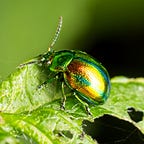Photographing Insects: The Little Ones
Small insects look amazing but are harder to photograph
I like small insects of less than a centimeter. Because they are so hard to see with the naked eye, the effect when you use a macro lens is more amazing. They can have wonderful detail and colors, but they are much harder to photograph. Here I tell you some things I learned.
An extended version of this article has appeared in my free book My Journey into Insect Photography that you can download here.
Finding them
In my previous article, I talked about finding insects. Finding small insects is obviously harder. It is though also a mindset. When you try to spot large insects you simply won’t see the small ones. Only when you deliberately try to spot small insects will you see them. It takes time for your brain to adapt to that. Often, in the beginning, I do not see them at all. But if I spent more time they start appearing everywhere.
Many small insects are relatively easy to approach. With my 100mm macro lens I do not have to get too close, which helps. As long as they sit still and there is basically no wind, it is relatively easy to photograph them, as long as you manage to keep your camera very still.
Once you look through the viewfinder you are often surprised. What looked like a little boring fly suddenly has beautiful colors or eyes. There are patterns, hairs, little antennas, and so on.
Focus
Focusing on small insects is hard. You use a higher magnification and, hence, the depth of field becomes very shallow. So you really need to focus exactly at the correct spot. Normally these are the eyes. I still prefer to use autofocus with the smallest possible focus area (spot) such that I am sure I focus on the correct spot.
But the eyes are small so it is very difficult to keep the camera still with the small focus area on the eyes. Also, the autofocus system needs a tiny bit of time to focus, so you need to hold the camera directed to that location and at the same distance. The faster the autofocus of the lens, the easier this becomes. You still need a couple of shots to get one that is sharp.
I also tried manual focus, but photographing handheld with these large magnifications, the keep rate becomes very small.
Also, I realized that it is useless to try to photograph such small insects when there is wind. It is impossible to focus with such high magnification on a moving leaf. A moving insect is also a problem. Try to guess where it is moving to and focus there. And be patient. It will stop moving at some moment.
Even when you focus perfectly, use a flash and a reasonably slow aperture (like F/13) the insect will most of the time not be fully in focus. The depth of field is simply too shallow. There are a few ways to improve this.
- If you take a top-down shot, almost all aspects of the insect are at the same depth, so you can get them all in focus. But these shots are often rather boring.
- A side shot has the same advantage and is way more interesting, but make sure the front and tail of the insect are indeed at the same distance. Also, the autofocus of the camera has a tendency to focus on the background instead. Refocus on a larger area at the same distance and then direct the camera to the insect and try to keep the focus there.
- It is not always important that the whole insect is in focus. When you take a shot from the front, only the heads need to be in focus. It actually guides the viewer to the important part of the image.
Post-processing
Even with a macro lens with a good magnification, the insect ends up small in the final image. Remember, a 1x1 magnification lens photographs a 36mm wide area. So an insect of 3 mm coves less than 1/10th of the width. With my APS-C camera, I can go up to some 1.5 magnification handheld, but after that focusing and depth of field become almost impossible to work with.
So a considerable digital crop is still required to make the insect large enough in the image. Don’t be afraid of that. My camera produces 32 MP images, while 8 MP is more than enough for almost everything, and even 4 MP and 6 MP images are still pretty good.
Because it is so hard to focus and the depth of field is so small, you might need some sharpening and additional dynamic contrast in post-processing, but only on the insect, not on the rest of the image. I described my process for this in a previous post.
Conclusions
Photographing small insects is very rewarding. They have amazing detail that you only see in the final image. It also feels like a great achievement, although it is actually not that hard. You don’t even need a macro lens with high magnification for it. Most images on this page where shot with a simple kit lens, with extension tubes. You do though need a large resolution such that you can use digital crop. Try it yourself, and you will be surprised by the results.
Next: August Shots
Previous: Finding Insects
Mark Overmars is a dedicated insect photographer that loves to share and regularly publishes about his work and about photography in general. You can visit his website at www.insectphotography.org. Download his free insect photography book at www.insectphotography.org/book.
